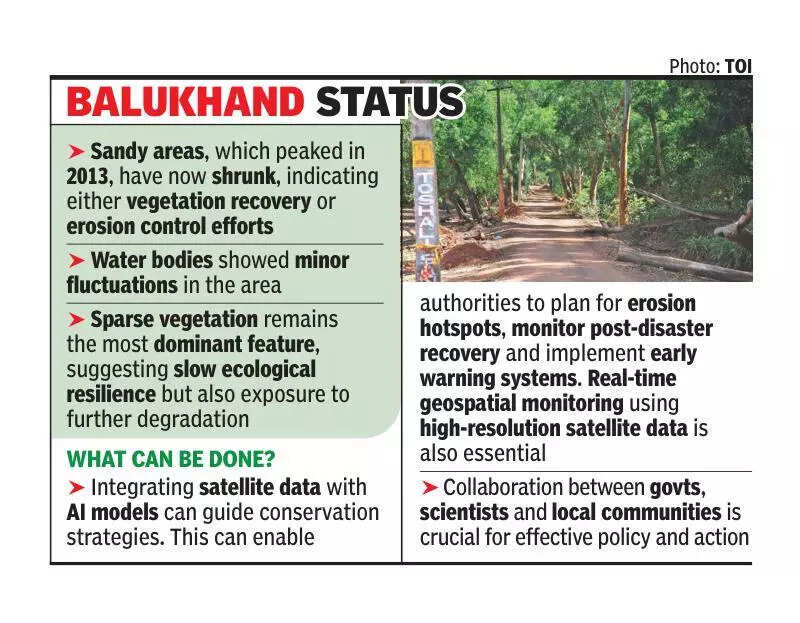Balukhand-Konark wildlife sanctuary facing ecological challenges: Study | Bhubaneswar News

Bhubaneswar: Along the coast of Odisha, nestled between the cities of Puri and Konark, lies the Balukhand-Konark Wildlife Sanctuary. It is a unique confluence of golden sands, whispering casuarina groves, a sprawling marine drive and nesting grounds for the endangered Olive Ridley turtles. But this ecological jewel is in peril.
A recent study found that dense vegetation in this sanctuary, home to spotted deer and blackbucks, has shrank from 41.8% in 1993 to 37.1% in 2023. Sparse vegetation now dominates over 50% of the area. Vegetation degradation peaks during years of intense cyclones like Fani, which devastated the forest canopy and altered the ecosystem permanently.
A team of researchers from Fakir Mohan University, Balasore, and Federal University of Paraiba in Brazil also found that northern shores are eroding rapidly, while the southern parts are seeing sediment deposition.
The study, recently published in a peer-reviewed journal, ‘Science of the Total Environment’, offers the most comprehensive look yet at the sanctuary’s evolving landscape. Led by Manoranjan Mishra of Fakir Mohan University, the study uses three decades of satellite data, processed through a combination of machine learning models to analyse changes in land use and shoreline from 1993 to 2023 and predict future trends through 2043.
The study revealed a troubling pattern in the vegetation. In 2002 and 2023, dense vegetation virtually vanished. In contrast, 2017 offered a rare moment of green revival. But overall, data shows a gradual shift from healthy, dense vegetation to sparse or barren landscape.
“This is not just about the loss of trees,” said Mishra. “It’s about the collapse of an ecosystem that supports migratory birds, animals like deer, reptiles and marine species like the Olive Ridley turtles.”
Cyclonic storms remain the biggest disruptors. Their analysis indicates that each major storm causes irreversible changes in vegetation, and their increasing frequency — linked to climate change — is worsening the decline.
The researchers observed an oscillating pattern of erosion and deposition. The early 2000s witnessed massive erosion. However, from 2013 to 2023, shoreline stability improved, with 91% showing accretion, possibly due to sediment deposition or conservation efforts.
Still, forecasts are alarming. “By 2043, some areas in the north could erode by over 51 metres, while southern sections may experience deposition up to 179 metres. The implications are dire for wildlife corridors, nesting grounds, and nearby human settlements,” said Mishra, quoting his research work.
A recent study found that dense vegetation in this sanctuary, home to spotted deer and blackbucks, has shrank from 41.8% in 1993 to 37.1% in 2023. Sparse vegetation now dominates over 50% of the area. Vegetation degradation peaks during years of intense cyclones like Fani, which devastated the forest canopy and altered the ecosystem permanently.
A team of researchers from Fakir Mohan University, Balasore, and Federal University of Paraiba in Brazil also found that northern shores are eroding rapidly, while the southern parts are seeing sediment deposition.
The study, recently published in a peer-reviewed journal, ‘Science of the Total Environment’, offers the most comprehensive look yet at the sanctuary’s evolving landscape. Led by Manoranjan Mishra of Fakir Mohan University, the study uses three decades of satellite data, processed through a combination of machine learning models to analyse changes in land use and shoreline from 1993 to 2023 and predict future trends through 2043.
The study revealed a troubling pattern in the vegetation. In 2002 and 2023, dense vegetation virtually vanished. In contrast, 2017 offered a rare moment of green revival. But overall, data shows a gradual shift from healthy, dense vegetation to sparse or barren landscape.
“This is not just about the loss of trees,” said Mishra. “It’s about the collapse of an ecosystem that supports migratory birds, animals like deer, reptiles and marine species like the Olive Ridley turtles.”
Cyclonic storms remain the biggest disruptors. Their analysis indicates that each major storm causes irreversible changes in vegetation, and their increasing frequency — linked to climate change — is worsening the decline.
The researchers observed an oscillating pattern of erosion and deposition. The early 2000s witnessed massive erosion. However, from 2013 to 2023, shoreline stability improved, with 91% showing accretion, possibly due to sediment deposition or conservation efforts.
Still, forecasts are alarming. “By 2043, some areas in the north could erode by over 51 metres, while southern sections may experience deposition up to 179 metres. The implications are dire for wildlife corridors, nesting grounds, and nearby human settlements,” said Mishra, quoting his research work.
















